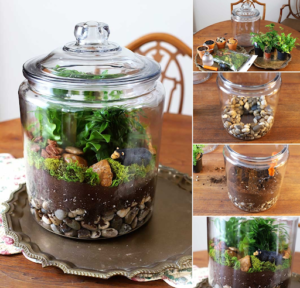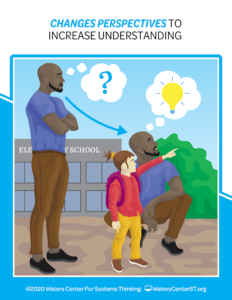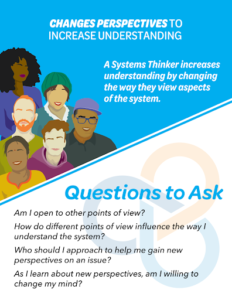Chapter 2: How Does Climate Change Affect Our World
Inquiry 1: Understanding Systems Thinking
- Provocations –Artefact
- Question Generation – Creative Question Starts, Compare and Contrast
- Knowledge Building – Video
- Determining Understanding – Habits of a Systems Thinker
- Pursuing learning – Think Feel Care
- Consolidation – I Used to Think, Now I Think
- Assessment – Invent and reflect, One Minute Sentence
- Take Action
This inquiry is focused on understanding systems thinking. “To think about systems means we pay attention to interrelationships, patterns, and dynamics as well as to the parts.” (Linda Booth Sweeney, Agency By Design, Project Zero at Harvard Graduate School of Education
Prior to Provocations: Journaling |
Encourage students to record their thinking and learning throughout the learning process. The main reason for developing a journal is for students to then be able to look back and track their growth and progression with their connection to climate change. Students scaffold their thinking throughout their learning journey. The entries can be a combination of personal reflections and assigned reflections. This can be done as illustrations, concept maps or written reflections. |
To hook student interest, introduce the provocation to initiate student thinking.
Artefact
The opportunity to handle actual artefacts is a unique experience. Students will inevitably be curious about the artefacts and this will naturally lead to good discussion.
Example Activity:

Bring a homemade or purchased terrarium (or a picture of a terrarium) to class. A terrarium is a self-sustaining plant ecosystem with living plants inside. It is usually made of a sealed, transparent container which contains all of the necessary parts that make up the ecosystem.
Explore all of the parts that make up the terrarium ecosystem. Consider what a plant ecosystem needs to survive (food, water and sunlight) and how all the elements (plants, soil, rocks, the container) all contribute to keeping the system working as an ecosystem. The plants and the soil in the terrarium release water vapour, essentially recycling water. The vapour is then collected onto the walls of the vessel and trickles down to the soil. The rocks in the bottom help to keep the soil from saturating so the water is absorbed as needed.
All of the parts of the terrarium contribute to its success, even the container. Students make connections to the idea that if something consists of many parts and functions as a system, the parts influence one another. If one part isn’t working properly, or if a part of a system is missing, broken, worn out, mismatched or misconnected, it affects the entire system.
Explore another example of a system, and see if students can identify the parts that make that system work. For example, using a bicycle, have students brainstorm all of the parts of a bike that make it work. Ask students to make simple connections from the parts to the whole: e.g., How do the wheels connect to the pedals? How do the pedals connect to the gears? How do the gears connect to the brakes?
Now explore some other systems and how the parts contribute to the functioning of the whole system; for example:
- Systems in my kitchen
- A bicycle as a system
- Planets in a solar system
- Computer and its components
- Human body system (e.g., digestive, circulatory, etc.)
This video by Linda Booth Sweeney makes a great introduction to systems thinking: What Are Systems?
Possible Discussion Questions:
- Choose one system that we encounter in our everyday lives and list as many of its parts as you can. What would happen if one of the parts was missing or malfunctioned?
- Think about your schoolyard as an ecosystem, list all of the parts. What would happen if one of the parts was paved to make a new parking lot?
- Can you think of a system we have discussed in class in the past and reflect on its components (e.g., water cycle, human body, solar system)
At this point in the inquiry, we want to harness students’ curiosity and build off of the provocations that have captured their interest by generating meaningful questions to continue to drive the learning process. This section will outline pathways for question generation depending on the provocation(s) that your class engaged with.
Use Creative Question Starts to provoke student thinking and further their inquiry.
Example Activity:
Using these question starters, have students come up with a list of questions regarding a living system:
- What if…?
- What is the purpose of…?
- How would it be different if…?
- Suppose that…?
- What if we knew…?
- What would change if…?
Have students write their questions on sticky notes, one question per note. Compare and contrast these questions with those generated for another system you explored in the provocation. Sort the questions into duplicate ones, those that can be answered with some simple research and those that may lead to a deeper inquiry.
At this stage, students may be ready to engage in a group knowledge building activity. It will encourage students to open their minds to many alternative ways of thinking about the provocations and ideas that have been generated thus far in the inquiry process.
The Mangrove Ecosystem Video by PBS’s Plum Landing explores how the parts of the ecosystem contribute to the success as a whole.
Example Activity:
Watch the video, then analyze the behaviours of the system:
- Identify the key parts of the mangrove as a system
- Examine the interconnections between the parts
- Explore how the behaviour of each part affects the behaviour of the other parts
- Identify how the interactions of all of the parts, working together, produce the overall behaviour of the entire system.
Use responses to inform and guide the learning process. They can provide insight into which concepts need clarity, what many students are already well informed about, and a general direction that many students want to pursue.
After viewing the Mangrove Ecosystem video(s) and participating in the provocation activities, explore this strategy to determine next steps.
From Habits of a Systems Thinker learning cards, address the concepts on this card to help students make some meaningful connections between systems that they have explored:


Example Activity:
Consider the systems that make our school function. Explore the parts (office runs the administration, classrooms, library, gym, schoolyards, parking lots, playgrounds, etc.) and identify other parts that contribute to making our school function. Allow students to express how these parts make the school function as a system and how this affects each students’ role at home, with their friends and as a learner.
At this stage, students may begin research to pursue some of their questions, or some of the following activities could be integrated into the process to ensure that students have an understanding of systems thinking. The activities listed below will enrich the understanding of climate change.
The Think Feel Care routine helps learners understand that people who participate in a system think, feel, and care differently about things based on their positions in the system.
Example Activity:
A system thinker changes perspectives to increase understanding. Use the Habits of A Systems Thinker card shown here, and the questions posed on the card to respond to Greta Thunberg and George Monbiot’s short film highlighting the need to protect and restore nature to respond to the climate crisis.

Example Activity:
Have students role-play different people in the school community that help the school function as a working system. Explore situations where decision making is necessary from different points of view. For example:
- It is raining outside and recess is approaching. Students have proper clothing and like to play in the rain. Make a decision on indoor recess from:
- the principal’s point of view
- a teacher’s point of view
- the custodian’s point of view
- the students’ point of view
- The friendly class snake escaped from its tank. Students love the snake and know that it won’t harm anyone who is kind to it. Some students are terrified and may try to harm it if found. Make a decision on what to do from:
- the principal’s point of view
- a teacher’s point of view
- the custodian’s point of view
- the students’ point of view
- It is raining outside and recess is approaching. Students have proper clothing and like to play in the rain. Make a decision on indoor recess from:
This step is designed to encourage students to integrate and synthesize key ideas. When students make connections and see relationships within and across lessons, this helps them to solidify knowledge and deepen understanding.
After students have had an opportunity to do some research on everyday systems, a valuable consolidation tool is I used to think…now I think.
Example Activity:
Using this strategy have students work individually or in small groups and respond to any or all of these statements:
- “I used to think that my sometimes silly actions, as a student in the school, didn’t matter; now I think…”
- “I used to think that not exercising my body regularly would just make me lazy; now I think…”
- “I used to think our school worked because adults made all of the decisions; now I think…”
These are just a few examples. Have students come up with other statements that demonstrate their understanding of the importance of all parts of a system needing to work together to make it function properly.
Teachers will assess learning at different points throughout the inquiry using multiple methods. The following assessment provides an alternative evaluation method to standard quizzes and tests that can be used after consolidation or at any point in the lesson to check for understanding.
Reflection:
Explain how the bicycle is a system that helps the world. It reduces carbon footprint and it is a healthy system.
Have fun with some Rube Goldberg machines! Invite students to invent a simple Rube Goldberg system that solves a problem in the natural world. Have students reflect on how their invention can help the world.
Here are some Rube Goldberg Lesson Ideas.
To form a concise summary, use the One Minute Sentence strategy.
Example Activity:
- List: During a lesson, have students make a list of the most important ideas of the lesson. They can do this individually or with a partner.
- Compose: Students review the important ideas they’ve recorded so far, then use what they’ve reviewed to compose one sentence to summarize the entire lesson individually.
- Mash Up: Students can also get together with a partner and compare sentences, take the main points from each other and co-create one richer sentence that demonstrates their learning and understanding in this inquiry.
These ideas for action can be utilized at any point in the learning process, whether it’s now or after completing more guided inquiries. Note, the suggestions are consistent in each chapter.
Allowing time for students to take action is an essential part of the learning process on climate change, as it empowers students and eases their eco anxiety.
Choose any or all of the 4 suggested videos to view, discuss and to spark an inquiry:
- Save Tomorrow [Young Voices for the Planet] 7:21 minutes
Inspired by the other Young Voices for the Planet films, three 9-year-old girls realize that they might be able to make a difference, too. These youth in Lexington, MA team up together to change a town law (with unanimous support!) to allow solar panels on public buildings. They then turn their passion towards protecting the local forest habitat. - How we children save the world [Plant for the Planet]: 5:21 minutes
The story behind Plant for the Planet—a youth perspective on how children can change the world and make a real impact in the climate crisis. - Canada Living Report [World Wildlife Fund] 0:59 seconds
WWF’s 2017 living planet report brings attention to the significant wildlife loss and takes a look forward to see “what can be done?”
- Artivism for Nature [World’s Largest Lesson] 2:02 minutes
Students explore what it means to be Nature Positive and design a creative image of a tree, uploading it to a virtual forest as a demonstration of their commitment to being Nature Positive and wanting others to be too.
Possible Discussion Questions:
- What is your favourite place to be outdoors?
- How are young people making their voices heard?
- How can a “nature positive” attitude help local habitats and biodiversity?
- Why is it important that all people have access to the outdoors?
- What are some outdoor spaces/places that all people and communities should have access to?
- Do all people have access to the outdoors?
- What is your favourite place outdoors?
Ideas for Taking Action:
- Plant trees
- Habitat restoration
- Collect data as citizen scientist such as local bird counts, schoolyard tree and plant surveys or participate in a local bioblitz
- Join student council and support initiatives and campaigns that help habitats and increase biodiversity
- Share your learning within your school and share your learning outside the class
Action Project Examples
- Ten Canadian Schools’ stories of Climate Action
This document outlines a collection of promising practices of climate action taking place in 10 Canadian UNESCO Associated Schools. These 10 schools participated in a worldwide UNESCO pilot project to implement climate action as recommended in the UNESCO (2016) publication, Getting Climate-Ready: A Guide for Schools on Climate Action.
- Young Voices for the Planet
This website documents youth speaking out, creating solutions and leading the change. These youth solutions to the climate crisis include stories of California kids banning plastic bags, Florida students saving their school $53,000 in energy costs, an 11-year-old German boy planting millions of trees and other young people changing laws, changing minds and changing society as they reduce the carbon footprint of their homes, schools and communities. Check out resources for Kids Taking Action here - The Great Plant Hunt from Ecoschool Global
The campaign aims to educate students about biodiversity, its importance and encourage them to take positive action. - Warming, Waste, Water, Watts, Wildlife (W5)
Through this project, thousands of students will be given opportunities to assess, design, and build innovative solutions to environmental challenges. - Community Conversations for Climate Change
In this activity, students talk to members of their community about some of the environmental and climate change they have noticed since they were young.